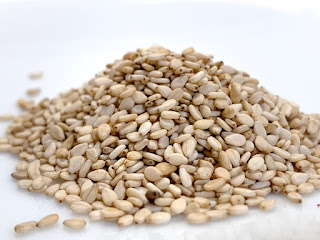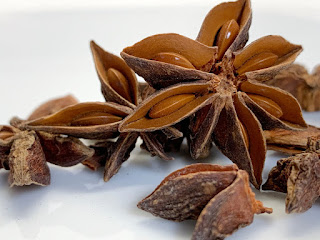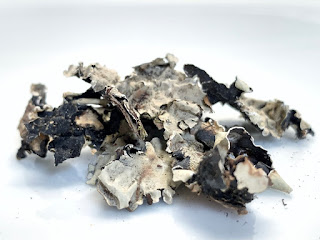I am not Indian. I have no particular Indian friends to help me out with this. I have, however, been cooking Indian foods for over 20 years now, and have run into a lot of unfamiliar words for things. I have spent countless hours poring over books and websites, trying to do this very same thing, and I feel at this point that I am fairly informed on the subject.
But still. I have not been to the source. I have no one to correct me. I am going on my own hard work and effort over all these years, learning. Always learning. And as I love spices, I will likely learn of more, as time goes by. Meanwhile, I hope these pages will help someone out there.
 |
| Black Salt |
Black Salt
A type of rock salt, salty and pungent, it is found mostly in the Himalayas. Black salt is comprised of several other components that give the salt its color (pink to purple) and smell (sulphur content). Though this salt can be produced from natural salts with the correct chemical compounds, it is commonly manufactured synthetically by adding ingredients and heating in a furnace. It is commonly used in Bangladesh, Nepal, India and Pakistan as a condiment added to things like chaats, chaat masalas, chutneys, raitas, salads and other Indian snacks.
Some Indian names for Black Salt you may encounter: Kala Namak, Bire Noon, Kala Noon
~~~~~~~~~~~~~~~~~~~~~~~~~~~
 |
| Black Sesame Seed |
Black Sesame Seed
(Sesamum Indicum ‘nigrum’)
Sesame seeds are all from the same plant, regardless of their color. Most commonly seen are white sesame, often on top of buns, but Black Sesame seeds have appeared more commonly over the years. In Indian cooking, they are cited specifically in an Assam sweet called “Til Pitha,” a thin cake with a black sesame and jaggery filling rolled inside. Some say that black sesame and white are the same except that the white have had the hull removed. Not entirely true. Possibly a polished black sesame seed would be white if its hull is removed, but white sesame seeds with their hull left on are a matte ivory beige in color (see below).
Some Indian names for Black Sesame Seed you may encounter:Til
~~~~~~~~~~~~~~~~~~~~~~~~~~~
 |
| White Sesame Seed |
White Sesame Seed
(Shown unhulled, not polished)
(Sesamum indicum 'alba')
Sesame, sometimes known as Benne, may have originated in Africa. Many wild relatives are found in Africa and India. Sesame has one of the highest oil contents of any seed. Sesame oil (called “gingelly” oil in India) is used in many recipes, for "tempering" (adding spices and other flavors last minute to a dish that alone is relatively bland, like lentils) and general cooking. To date, I have not seen many sesame seeds of either black or white variety used in Indian recipes, except for sweets of various kinds, used like a peanut brittle. Sesame seeds appear to be used more in southern Indian foods.
Some Indian names for White Sesame Seed you may encounter:Til
~~~~~~~~~~~~~~~~~~~~~~~~~~~~
 |
| Star Anise |
Star Anise, Chinese Star Anise
(Illicum verum)
Star Anise is the dried fruit of an evergreen tree indigenous to south eastern China. Produced almost entirely in China and Vietnam, there is small production in Arunachal Pradesh, in India. Generally considered an “exotic,” Star Anise can be used as an ingredient in Garam Masala and to flavor rice and meats. It is most often added whole to a dish and discarded before serving. It is often added to spiced masala chai mixtures and to most biryani dishes and slow cooked curries, potato dishes and garbanzo dishes.
Some Indian names for Star Anise you may encounter: Badian, Badyani, Anasphal, Chakri Phool, Chakri Phul, Badal Phul
~~~~~~~~~~~~~~~~~~~~~~~~~~~
 |
| Black Stone Flower Lichen |
Stone Flower, Black Stone Flower
(Parmotrema perlatum)
Typically used as a spice in Chettinad and West Indian (Maharashtrian) cuisines, Stone Flower, a type of lichen, has little flavor on its own and must be cooked in a little oil to release its flavor. The flavor is described as “strongly woody and with a cinnamon-like aroma and flavor.” It is typically used in meat dishes, some vegetable or lentil dishes (like my Punjabi Chole). Try it in Butter Chicken or Chicken Tikka.
Some Indian names for Stone Flower you may encounter: Dagad Phool, Kalpasi, Bojhwar, Raathi Pootha, Patthar ka Phool
~~~~~~~~~~~~~~~~~~~~~~~~~~~~
 |
| Tamarind |
Tamarind
(Tamarindus indica)
A tree in the family Fabaceae, Tamarind is indigenous to tropical Africa, but has been cultivated for so long on the Indian subcontinent that it is considered by some to be indigenous there. The dried brown fruit pod contains dense, sticky, edible pulp surrounding black, shiny seeds which must be removed before use. The outer shell cracks off easily. The sticky fruit can be soaked for easier use. Tamarind is used most often in southern Indian cuisine and is considered a souring agent, like Mango Powder and dried Pomegranate Seeds (instead of using lemons or limes). Used most often in the southern parts of India, find it in many sauces for curries, vindaloo, sambar, lentils and dals, chutneys.
Some Indian names for Tamarind you may encounter: Imli, Amli
~~~~~~~~~~~~~~~~~~~~~~~~~
 |
| Turmeric Rhizome |
Turmeric
(Curcuma longa)
More often seen in its bright yellow powdered form in the U.S., the vivid yellow orange rhizome (ginger family, Zingiberaceae) of this native of the Indian subcontinent and southeast Asia is known in many Asian cuisines, imparting strong yellow color and its warm, pungent, bitter, pepper-mustard-like flavor to savory dishes, though it lends color to widespread other products. In Indian cuisines, it is a usual component of curry powders, and commonly added to curries, masalas, pickles, dals, lentils, vegetables and many other foods to amp up color and flavors.
Some Indian names for Turmeric you may encounter: Haldi, Haldee, Huldi
My passion is teaching people how to create a harmony of flavors with their cooking, and passing along my love and joy of food, both simple or exotic, plain or fancy. I continue my journey in ethnic and domestic cuisines, continuing my journey to explore diverse culinary experiences and hopefully to start you on a journey of your own. Join me also at A Harmony of Flavors on Facebook, and Pinterest.

No comments:
Post a Comment